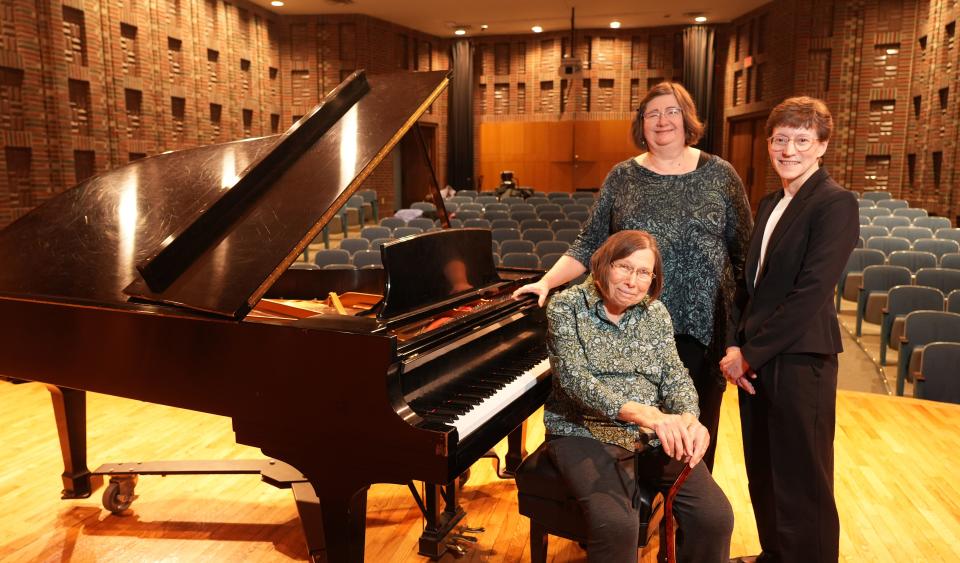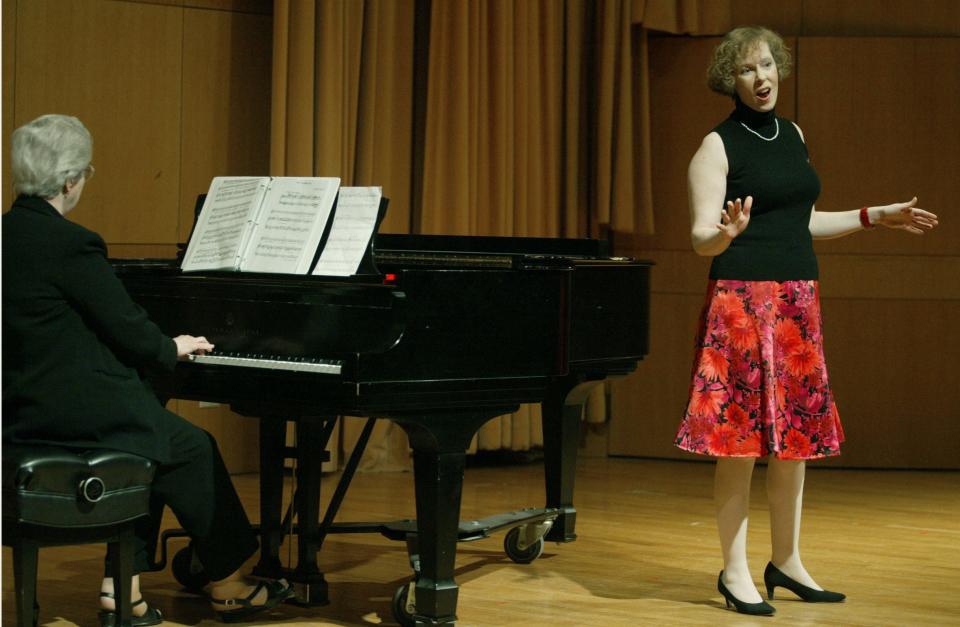After 141 years, Women in Music-Columbus has disbanded
Over the course of a long and storied history, Women in Music-Columbus has enjoyed that rarest thing in the performing arts: staying power.
Some 66 years before Chamber Music Columbus began presenting national artists and ensembles, 69 years before the earliest incarnation of the Columbus Symphony came into existence and 96 years before the ProMusica Chamber Orchestra was established, Women in Music-Columbus was building the central Ohio classical-music scene — and enriching the lives of its members.
Since its founding in 1882, the organization has served as a home for area female instrumentalists and vocalists who, through a rigorous audition process, became members and presented private and public concerts.
“I think it really did help put Columbus on some kind of cultural map,” said Phyllis Byard, a 90-year-old Worthington resident whose own membership in the group goes back about 55 years.
“People heard music and saw performances they never would have seen had we not existed,” said Byard, who herself was a vocalist. “I would not have had the opportunities to sing my heart out.”
Last year, after 141 years of existence, Women in Music-Columbus decided to wind up operations. Citing declining membership, leaders voted to dissolve the group and donate the funds it had on hand, about $245,000, to the Columbus Foundation. That check was cut in November.

“I was very sad to see the group dissolve because (we) had so many wonderful experiences,” said Karen Gardener, a 56-year-old Hilliard resident who had been voted president-elect of the group prior to its dissolution. “I also recognized times are different.”
A storied past
But, for nearly a century and a half, the group managed to keep itself going.
At the time of its founding, the organization then known as the Ladies’ Musical Club drew its roster from central Ohio women who had been trained in an instrument, or who sang, but had little access to professional performing opportunities.
More: Q&A: Author Michele Norris explores racial identity in 'Our Hidden Conversations'
“Women had not gotten the opportunity to play in orchestras,” Byard said. “The only way genteel ladies had the chance to get together and show their stuff was to each other.”
Responding to the need, Mary Failing turned her home on East Broad Street into a recital venue for members. In time, other members stepped forward to offer their homes as recital venues, too.
“(Members) were wives of important men who were businessmen here in town,” Byard said. “The women had spare time, and probably spare money, and a lot of talent. They were frustrated. I think that’s probably what started it all.”
Eventually, the group — by 1905, known as the Women’s Music Club — attracted large enough audiences to shift to public performances. For decades, the Franklin County Memorial Hall hosted performances by member musicians.
Plus, the organization invited an impressive array of internationally known guest performers to Columbus, including composer and pianist Percy Grainger, pianist Vladimir Horowitz and singers Nelson Eddy and Jeanette MacDonald. Chamber music ensembles and even whole orchestras also performed under the group’s banner.
“That was part of the glamour of the group,” Byard said. “We were bringing in symphony orchestras to Columbus. We were bringing culture to Columbus, and nobody else was.”
Above all, though, the organization existed to serve its members, whose annual dues (which had risen to $50 in recent years) came with the promise of performing.
“We tried to be equitable and give people the opportunity, when they renewed their dues, to request a performance the coming year and say what they would like to perform,” said Byard, whose own membership in the group she describes as deeply fulfilling.
“I had taken lessons a lot, but I had no aspirations to be a professional musician,” she said. “This was an outlet for me that was beyond belief. I’ve managed to help raise six children and have a domestic life here in Columbus, and not have to go through the rigors and burdens of a professional (musician’s) life.”
Remaining relevant
Even as the central Ohio classical-music scene strengthened thanks to the development of the Columbus Symphony and the emergence of ProMusica, Women in Music-Columbus — as the organization was finally called — still had a robust presence.
In addition to recitals for small numbers of musicians, the organization had sufficient numbers to fill the ranks of a series of larger homegrown ensembles, the Choral Ensemble, String Sinfonia and Columbus Women’s Orchestra. Over the years, the group’s regular performance venues shifted to stages at Capital University and Otterbein University. Members also ventured forth into the community to perform.
“Churches, retirement centers, nursing homes,” Byard said. “It doesn’t sound terribly glamorous, and it wasn’t, but it was still fulfilling and rewarding to be able to do it.”
More: 'The Color Purple': Short North Stage to launch monthlong run of Broadway hit
Fundraising, grants and private donations — including $50,000 from Tom Lesher, a former student of Women in Music-Columbus member and Columbus Symphony musician Mary Lane — enabled the group to establish scholarships, the Young Artist’s String Competition and the Mary Lane Memorial Violin Competition.

Also notable was the organization’s support of female composers. Every two years, a call was put out to solicit compositions by women that could then be programmed during recitals or concerts.
“Mostly we looked for chamber-music pieces that involved three to five people or something like that,” said Cynthia Mahaney, 64, a two-term president of the group, from 2007-2009 and 2014-2018, who now lives in Howard, Ohio. “Then you received all these scores, and you had to sit down and listen to all these recordings.”
Mahaney points to a proud moment during her tenure: In 2008, when the Columbus Symphony temporarily shut down because of labor disagreements between musicians and management, Women in Music-Columbus stepped forward as the organization that collected donations for the musicians.
“(The symphony musicians) wanted to perform publicly so that the public would have the opportunity to support them through ticket donations,” Mahaney said. “It had to be a donation to a 501(c)(3) organization; they couldn’t just give them the money directly. . . . We were the organization through which members of the public gave money to the members of the symphony.”
Waning interest
Yet, at some point after the turn of the millennium, participation among members started to wane.
Membership — which, at its modern peak, numbered about 300, according to Byard — began to fall off as women in general led increasingly busy lives. Plus, those with the training and talent to make music could now do so with orchestras and ensembles.
“Compared to 141 years ago, women have more choices now. They can be professional musicians,” Mahaney said. “That was not the case when it started, and that was the reason why it started — to allow women to have the opportunity just to perform.
The group’s ensembles — the Choral Ensemble, String Sinfonia and Columbus Women’s Orchestra — eventually disbanded.
“The orchestra had withered for lack of personnel, and likewise the choral,” Byard said. “(String Sinfonia) died a sad death. . . . The quality started to go, so we didn’t feel we could in good faith present to the public.”
Those members who were still committed to the group were aging.
More: Columbus Metropolitan Library's Carnegie series brings noted authors to town
“Membership was a big issue, because a lot of the members who had been most active were getting older and just weren’t able to do as much,” Gardener said. “It was just harder to find more people who had the time to invest in it.”
The COVID-19 pandemic was, Byard said, “the punctuation point” on an extended period of decline.
Women in Music-Columbus presented three concerts in the spring of 2022, but, by then, leaders were seriously looking at ending operations.
“We didn’t have enough performers, we didn’t have enough staff, so we had to come to some kind of finality,” said Byard, who cited the organization’s bylaws, which had mandated that, upon the dissolution of the group, its remaining funds would go to the Columbus Foundation.
That money will now support what is called the Women in Music-Columbus Legacy Fund, which will provide scholarships and grants.
Call it a fitting final note to an organization that has long made Columbus a more tuneful town.
Said Mahaney: “I’m just really proud of how many women and musicians we got to support through the years.”
This article originally appeared on The Columbus Dispatch: Women in Music-Columbus saying goodbye to central Ohio
